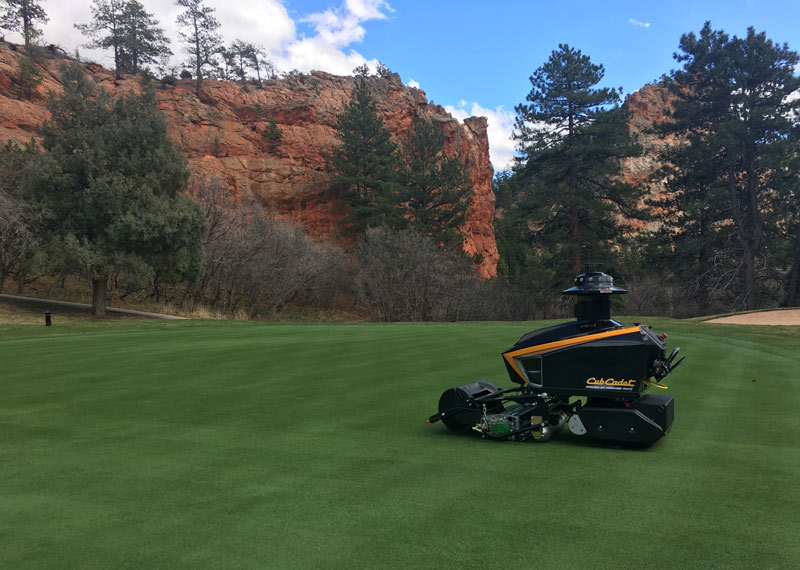
One of the four Cub Cadet RG3 robotic greens mowers in the lineup at Perry Park Country Club in Larkspur, Colo. Photo courtesy of Justin Daigle
“You’re not going to believe this.”
That’s what Jeff Miller, GCSAA Class A superintendent at The Santaluz Club in San Diego, told his assistant superintendent last Tuesday after a phone call with Tony Whelan, director of sales and marketing for Cub Cadet.
The news Whelan had called Miller to deliver? Cub Cadet is shelving its autonomous turf mower program, a pause that may or may not be permanent. Whelan cited technical issues with what was supposed to be Cub Cadet’s newest autonomous mower, the RGX, as the reason behind the decision.
Cub Cadet, which operates under parent company MTD, introduced the RG3 robotic greens mower to the market in 2015. The RGX was scheduled to be released sometime in 2020.
“The message is that we take our commitment to quality extremely seriously,” Whelan told GCM last week. “We are unwilling to bring any product to the market that doesn’t meet our customers’ expectations and specifications.”
Miller is one of those customers. He owns five RG3 mowers and has another on loan, and says implementing them has saved time and money at his club. Miller says he was planning to upgrade to the RGX, which was to feature a real-time kinematic (RTK) GPS system (RG3 did not have RTK GPS). The RGX was showcased in January at the 2020 Golf Industry Show in Orlando, Fla.
When he spoke with GCM in the days after receiving what he described as “out of the blue” news, Miller was busy seeking greens-mowing alternatives and still trying to process Cub Cadet’s decision. “I was dumbfounded. Definitely shocked,” the 20-year GCSAA member says.
The clubs that have been using the RG3 — Whelan says “it was a small number” — were not only contacted by Whelan, but also received a letter from Cub Cadet about the decision. Whelan says Cub Cadet will continue to support the units as it works with its customers on a transition plan for each specific site, and he adds that a plan is in place to return the mowers to Cub Cadet. “The gist of it (the letter) was, based on our challenges, we’re making this decision, and we’re going to work with you to transition out into an alternate method,” Whelan says.
The move by Cub Cadet, which was first reported by Golf Course Industry, was made following a six-month field trial of the RGX in the U.S. and Canada that concluded in January. “Later in the stages of that field trial, we uncovered a couple of technical challenges that were going to not allow us to meet certain specifications,” Whelan says. “One of them was significant enough that we had to put the project on hold.
“It was a very difficult decision, but the decision is based on our core value. We’re just not going to provide something to the market that doesn’t meet the customers’ expectations and needs. We believe this technical challenge is a pretty big challenge for us, so we, for the short term, are refocusing a lot of our resources and efforts in other areas as we consider how to solve this.”
Whelan would not elaborate on details of the technical issues.
John Shaw, CGCS, is another superintendent who has been using the RG3. Shaw, a 29-year GCSAA member who oversees Valley Brook Country Club in McMurray, Pa., says he thought Whelan was calling him last week to discuss moving forward with the RGX. “I thought we were going to be the first club to have it,” says Shaw, who tested the RGX and planned to get six of the units for, according to Shaw, a total price of $400,000.

The Cub Cadet RGX prototype during testing at Valley Brook Country Club in McMurray, Pa. Photo courtesy of John Shaw
“I felt they (Cub Cadet) were on the right track. I thought they had it. It was almost in the end zone. It (testing the RGX) was successful on Poa annua/bentgrass. We ran them here for two weeks, and they worked just perfect. At my golf course, they cut straight lines, and there were no GPS issues. It was a home run. Our members see the difference (in greens maintained with the RG3), knew it was worth the money. They see the same perfection on putting greens I see.”
Now Shaw, like others, is seeing what else is on the market. In fact, he says he has been looking at other options since last year. “I assured everyone at our club (last fall) that I had a Plan B,” Shaw says.
Miller, who also has five of Cub Cadet’s Infinicut walk-behind mowers, says he will miss saving the approximately 13,000 hours of labor he eliminated over the more than three-year period of using the RG3, which allowed his crew to handle other tasks while the RG3 did its thing. “That’s (saving) a quarter of a million dollars,” says Miller, who adds that he still supports Cub Cadet.
Although Whelan indicated that a potential revival of autonomous mowers at Cub Cadet is a never-say-never scenario, he cannot promise it. For the moment, Cub Cadet is focused on its other products, including the Infinicut. “I don’t want to create false expectations. We are describing it right now that it is on indefinite hold,” Whelan says.
Justin Daigle, GCSAA Class A superintendent at Perry Park Country Club in Larkspur, Colo., delivered a passionate presentation about autonomous mowers last month at the Golf Industry Show. He is among those who use the RG3 — he had three years remaining on a five-year lease of the product at the time of the announcement and was looking forward to the RGX. Daigle says Cub Cadet has been “super helpful” in assisting with the transition following last week’s news, but the turn of events is still disappointing.
“I just don’t see another product anytime soon, or ever, that produced a surface like the RG3,” says Daigle, a 20-year GCSAA member, whose club leased four RG3 mowers for a fair market value of $36,000 annually. “It produced a pure end product. Pure surface. It was like Superman mowing a green.”
Other companies, meanwhile, are investing in the autonomous age. Among them are Husqvarna, Toro, which showcased its GeoLink Solutions technology for autonomous mowing at GIS, and John Deere, which has teamed with Precision Makers to develop autonomous mowing solutions. European company Turflynx is in the game with autonomous fairway mowers.
Daigle says he has been contacted by other companies about autonomous mower possibilities, which hasn’t surprised him. “Autonomous mowers in our industry are not dead,” Daigle says. “It’s our future. It just is.”
Editor’s note: Read much more about the future of autonomous technology in the golf industry in the April 2020 issue of GCM.
Howard Richman is GCM’s associate editor.